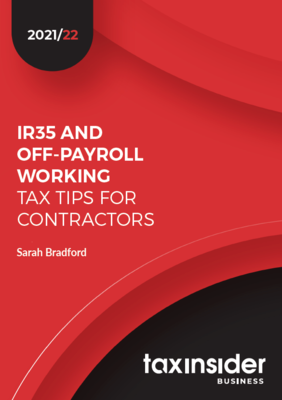IR35 and Off-Payroll Working – Tax Tips for Contractors
IR35 tax is confusing and a common tax trap for contractors and companies. Use this report, written by a
renowned tax expert to avoid IR35 tax traps and to learn more about IR35 implications.

Why get the IR35 Tax Tips for Contractors Report?
Off-payroll working and IR35 tax are areas that create a lot of discussion amongst tax advisers and taxpayers, and some confusion too.
Since their introduction the original IR35 have been modified and extended and to a large extent replaced by the off-payroll working rules, which move the burden of determining whether the anti-avoidance rules apply, and complying with them if they do, from the contractor to the end client. The off-payroll working rules were introduced from 6 April 2017 where the end client is a public sector body. They are extended from 6 April 2021 so that they also apply where the end client is a medium or large private sector body.
In this special 15,500+ word report, Sarah Bradford explains the nature of the IR35 rules and the off-payroll working rules, and explain when each apply. She also gives some useful pointers and tips to make sure contractors don’t fall into the common IR35 traps.
The commentary that follows sets out the rules as they apply from 6 April 2021.
What Does the IR35 Tax Tips for Contractors Report Cover?
Updated to reflect the changes coming in April 2021, this in-depth report covers everything you need to know about IR35 tax including:
- IR35 legislative framework and the HMRC guidance
- Why IR35 matters
- Key Terms
- Notional Contract Of Service
- Employed Or Self-Employed?
- Determining Status In Marginal Cases
- Check Employment Status for Tax Tool (CEST)
- Outside IR35 And Off-Payroll Working – The Tax Implications
- IR35 Applies – The Tax Implications
- IR35: The Deemed Payment
- IR35: Deduction For Expenses
- IR35: Reporting The Deemed Payment
- IR35: HMRC Enquiries
- Failsafe Contract
- Travel Expenses And Intermediaries
- The Off-Payroll Working Rules
- Impact Of The Off-Payroll Working Rules On The Worker
And so much more. Take a look inside to see how the IR35 Tax Tips for Contractors report can save you time and money by making IR35 tax implications easy to understand.
Who is the IR35 Tax Tips Report for?
Any contractors that feel they fall under the IR35 tax regulations will benefit from reading this report.
Employers and company owners who regularly work with contractors will benefit from learning when IR35 applies to them in order to avoid IR35 tax traps.
It isn’t just contractors and companies that will benefit from this report. Any tax professionals and accountants who want a better understanding of the implications of IR35 will benefit from owning this comprehensive report.
The IR35 Tax Tips report will help you stay on the right side of the law while maximising your tax planning capabilities.




